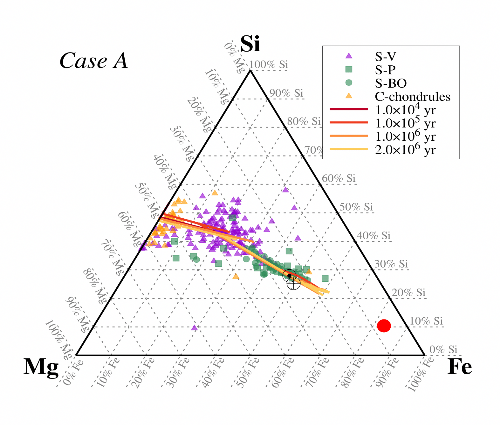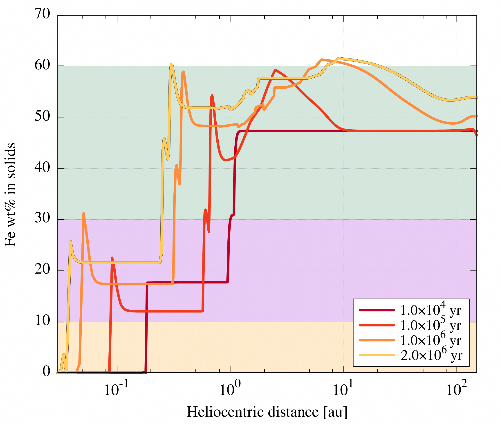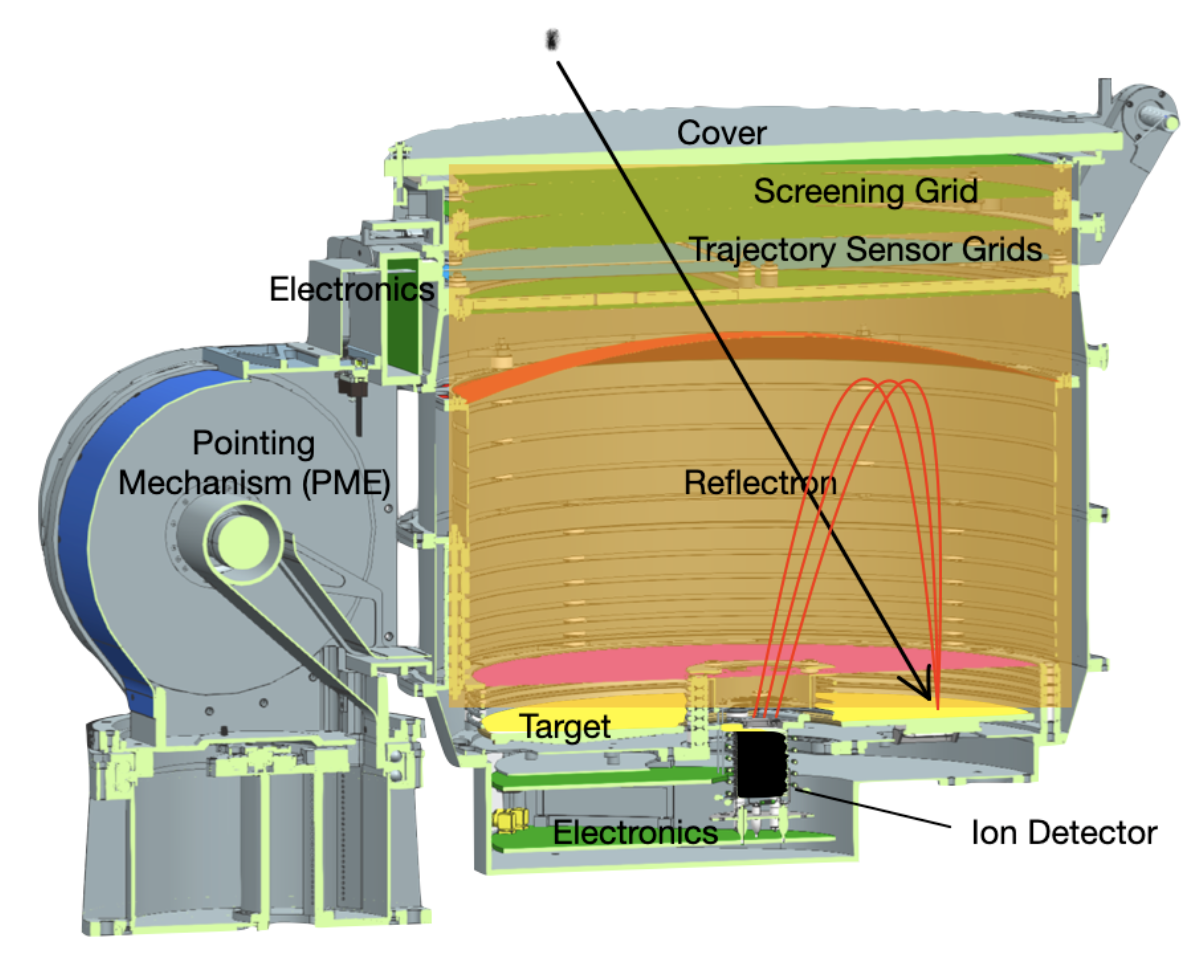Rare presolar grains originating by condensation in circumstellar atmospheres are known from meteorites [1]. These escaped processing in the solar nebula and are identified via their extremely diverse isotopic composition [1,2]. However, it is uncertain if such grains are representative for dust from the interstellar medium (ISM) [3–5], particular as [5] postulated a high fraction of interstellar grain population that formed directly in the ISM.
In 1992 the Ulysses spacecraft discovered a dust flow from the Local Interstellar Cloud (LIC) [6]. During the Cassini mission at Saturn, the Cosmic Dust Analyser (CDA) could identify and analyse the chemical composition of 36 individual interstellar dust (ISD) particles [7]. These grains were distinguished from Saturn bound dust by their direction and high velocity. Their mean mass is consistent with the typical size [3-5] derived from astronomical observations. As major result, each individual ISD grain contains the major rock forming elements (Mg, Si, Fe, Ca) in roughly cosmic abundances, indicating compositional homogeneity at spatial scales as small as 100 nm. In contrast, CDA did neither detect carbon-rich grains such as graphite or SiC, nor pure metal grains (upper limit of 8% at the 2 sigma confidence level) [7].
This homogeneity cannot be reconciled with isotopically and compositionally diverse populations of circumstellar dust inherited from AGB stars and supernovae found in meteorites. These grain populations consist mainly of silicates with a more diverse composition (e.g., olivine, pyroxene), however, also minor contributions (few %) of Al-oxides (e.g., corundum, hibonite), as well as carbonaceous grains (mainly silicon carbide) which contribute 20-50%, of the grains in the most primitive meteorites [2]. In contrast to circumstellar grains found in meteorites, the LIC-ISD grains detected by Cassini have a much lower variation of Mg/Si or Mg/Fe ratios [7], and appear to be a grain population homogenized by destruction, recondensation and equilibration processes in the ISM. This can be reconciled with astronomical observations of the diffuse ISM demonstrating that condensable elements of atomic mass >23 are depleted in the gas phase and hence bound in solids. Considering that the mean lifetime of ISD grains against destruction by supernova shocks is much shorter (c. 0.5 Ga) than the average residence time of ISM matter of 2.5 Ga [5], an origin of a high fraction of ISD by grain destruction followed by recondensation was suggested by [5,7]. While grain destruction most likely occurs in the hot interstellar medium, i.e., low-density cavities formed by supernova shock fronts, condensation likely occurs in the cold interstellar medium, i.e., cold molecular clouds which are also formation regions of stars and planets.
The upcoming DESTINY+ mission [8] will be equipped with an improved impact ionization mass spectrometer, the DESTINY+ Dust Analyser (DDA). During the mission, hundreds of ISD particles are expected to be measured [9]), yielding high quality mass spectra with a resolution of c. 100-200 when compared to c. 20-50 of Cassini CDA [10]. This will allow much better resolution of mass peaks at 23-28 amu (Na, Mg, Al, Si) and 39-41 (K, Ca), particularly yielding improved constraints on abundances of Al and Si. This will allow, e.g., to distinguish between Mg silicates like pyroxene and olivine or Al-rich feldspar type silicates. Also, more precise values for Na and K can be expected, particularly as some of the Cassini CDA data were compromised by alkali contamination of the Rhodium target [7]. Furthermore, the higher number of ISD particle detections will allow to better quantify the ISD fraction of non-silicate particles (oxides, SiC, graphite, metal, see [1]). This will also provide constraints on dynamic forces acting on the ISD particle flux, particularly the question if high beta particles are preferentially deflected from the inner solar system by solar radiation forces. Finally, DDA measurements will also contribute to solve the problem of apparently low or “missing” organic components in CDA detected particles, which may be caused by volatilization of refractory organic material in ISD mantles upon entering the heliosphere [11].
Hence, interstellar dust detections by the DESTINY+ Dust Analyser will likely improve our understanding of the chemical nature of interstellar dust, its processing and lifetime in various phases of the interstellar medium, possible processing and volatile loss upon traversing our solar system to 1 AU, flux modulations upon interaction with solar electromagnetic forces, and last but not least, a tight age constraint on the LIC dust.
References:
[1] E. Zinner (2014) In Meteorites and Cosmochemical Processes (ed. Davis A. M.). Elsevier, Amsterdam, pp. 181–213
[2] J. Leitner, C. Vollmer, P. Hoppe, J. Zipfel (2012) Astrophysical Journal 745, 38
[3] P. C. Frisch et al. (1999) Astrophysical Journal 525, 492
[4] H. Kimura, I. Mann, E. K. Jessberger (2003) Astrophysical Journal 583, 314
[5] S. Zhukovska, H.-P. Gail, M. Trieloff (2008) Astronomy & Astrophysics 479, 453
[6] E. Grün et al. (1993) Nature 362, 428-430
[7] N. Altobelli, F. Postberg, K. Fiege, M. Trieloff et al. (2016) Science 352, 312
[8] H. Arai, M. Kobayashi, et al. (2018) Lun. Planet. Sci. Conf. 49, abstr. #2570
[9] Krüger H., Strub P., et al. (2019) Planetary & Space Science 172, 22-42.
[10] Srama R. et al. (2004) Space Science Reviews 114, 465-518.
[11] H. Kimura, F. Postberg, N. Altobelli, M. Trieloff (2020) Astronomy & Astrophysics 643, A50




